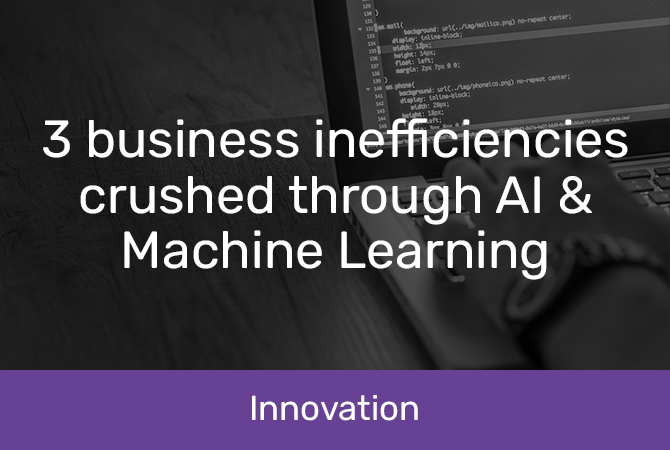
3 business inefficiencies crushed through AI and Machine Learning
Thanks to science fiction, there are plenty of assumptions about what Artificial Intelligence is. It’s imagined as the power behind complex and fabulously useful semi-sentient beings that control spaceships, govern worlds and inevitably try to exterminate humanity.
Fun to read or watch, but quite far from the truth – especially in business.
![]() What is Artificial Intelligence versus Machine Learning?
What is Artificial Intelligence versus Machine Learning?
Artificial Intelligence can be defined quite simply: it is a computer program that tries to emulate the human brain, allowing the program to make the kinds of decisions and perform the kinds of tasks that humans can. Machine Learning is one method of achieving that. It’s a process that learns from its mistakes, ensuring it doesn’t make the same mistake twice.
One example is AlphaGo, an intuitive AI programme that is designed to play a popular board game ‘Go’. It’s able to use previous data to use established tactics to defeat opponents, but it also create new, inventive tactics on its own. It is AI that learns and interprets, using Machine Learning.
Artificial Intelligence's use in business is the same, at its core – using historical data and learning programming to make human-like decisions, or at least inform them.
Why AI is so useful in defeating business inefficiencies
Due to its ability to learn and self-regulate, Artificial Intelligence in business can be used to do two extremely useful things. Firstly, an AI application can be trained to perform mundane but complex tasks (for a computer) like data entry, task prioritisation and so on. Jobs that normally need human understanding of the world can be automated instead because of the AI’s ability to correct itself.
Secondly, AI can be used to predict the likelihood of certain outcomes. When an AI-driven model predicts something will happen and is wrong, it can correct itself for next time. Provide it with historical data and allow it to simulate thousands (or millions) of outcomes from it, and you get a model that is highly accurate and dependable when applied to ‘living’ data. And it only gets more accurate the more data you give it.
This is just the start of what AI can do for business, but here are a few practical examples of what we’ve described.
1. Using AI to automate manual processes
Consider a local council which needs to keep records of the size of its constituents’ homes for rate-setting purposes. When certain new homes are entered into this database, a human staff member must manually review the blueprints, measure out the footprint and enter that data. This can take hundreds of hours every year – a significant amount of time for a relatively trivial task.
Rather than swallow the cost in human resource, the council turns to Artificial Intelligence. Normal automation technology is unable to interpret blueprints, but AI can be ‘trained’ to recognize them, translate them into measurements and enter them into the database automatically. In fact, the AI program even learns how to estimate blueprints when architects have been unclear about exact measurements on the documentation – something a human staff member would have trouble doing without a lot of experience.
As a result, council employees have more time to spend on tasks better suited to a human hand, while the AI deals with the tedious manual process – and does it faster and more accurately, too.
2. Using Machine Learning to better allocate marketing resources
Consider a nationwide retailer that generates most of its income from high-value, large-purchase customers. This retailer intends to capitalise on customers most likely to make a purchase over $1,000 in the next 90 days. They will do this by targeting them with marketing materials that are designed to encourage them towards their large purchase.
![]() The challenge is knowing which people are likely to make such a purchase. While these high value consumers share certain traits, these traits can interact with one another and are weighted differently, every customer having unique circumstances that may affect their likelihood.
The challenge is knowing which people are likely to make such a purchase. While these high value consumers share certain traits, these traits can interact with one another and are weighted differently, every customer having unique circumstances that may affect their likelihood.
Rather than targeting every single customer that has a “high value” trait, which would be extremely resource inefficient, the retailer turns to Machine Learning instead. Deep inside the data, there are signals and patterns that allow us to predict what a given customer is likely to do. On the surface, this can seem like a random selection of purchases and behaviours, but Machine Learning can make sense of the diaspora of data.
The model structure allows data to flow through a series of self-adjusting calculations that eventually results in a prediction of whether a given customer is likely to make a large purchase. The retailer can use this information to direct marketing resources towards those most valuable customers, avoiding an expensive and ineffective marketing campaign that may or may not have hit the right people.
3. Using AI and Machine Learning to predict project effectiveness
Consider a telecommunications company that has operations regularly held up by flooding around its high-traffic copper wiring infrastructure. The telco regularly dispatches a technician for maintenance on its wiring. Often, these technicians discover that the pipelines in which the copper wiring is installed have been flooded. The technician calls out a “sucker truck” and must wait for the area to be pumped before work can begin.
The technician’s time is valuable, and when they have to spend an hour or two waiting, the company suffers a measurable drop in efficiency. Even after the pumping is complete, the technicians are often caught up with additional work because of the flood – repairing copper wiring damaged by corrosion, for instance – before they can complete the regular maintenance tasks.
![]() The telco company therefore wants to install an early warning flooding system so that this challenge can be more proactively managed, with technicians being able to react more quickly and complete their maintenance tasks before being forced to wait for a pump. Unfortunately, the benefits of this plan of action are difficult to quantify, as it’s unknown whether it would make up for the expense of installation. In order to determine this, the telco company needs something that simulates what would happen were flood-induced tasks removed from the equation.
The telco company therefore wants to install an early warning flooding system so that this challenge can be more proactively managed, with technicians being able to react more quickly and complete their maintenance tasks before being forced to wait for a pump. Unfortunately, the benefits of this plan of action are difficult to quantify, as it’s unknown whether it would make up for the expense of installation. In order to determine this, the telco company needs something that simulates what would happen were flood-induced tasks removed from the equation.
An AI application can do that. By using a predictive model, the AI software is able to quantify how much time (and capital) the telco would likely save by managing flooding proactively. After analysis, it’s discovered that installing the early warning system would be a net gain to the telco company. The early warning system is implemented, the company’s uptime is improved and the overall business efficiency is increased. This AI-driven predictive model gives them the confidence to invest in a system, rather than risking capital expenditure only to discover the flooding was not the root cause of extended maintenance time.
Summary
These are just a select few applications of AI and Machine Learning in business. Ultimately, its use comes down to one overriding goal: removing business inefficiencies. Whether that’s automating operations or informing high level strategy through accurate predictions, AI in business can be the difference between stagnation and success.
Download the Datamine Guide to Predictive and AI Modelling below to learn more about how you can implement AI and Machine Learning applications in your business.















































